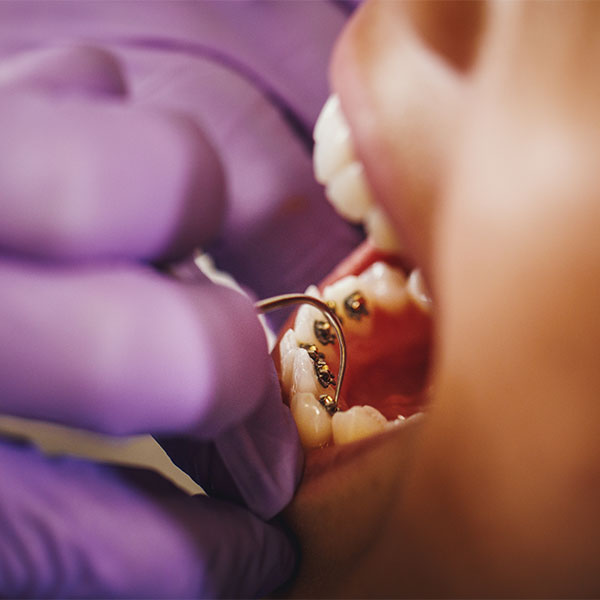Invisible braces (Lingual orthodontics)
Lingual orthodontics, or invisible braces, is the correction of teeth with the help of brackets and braces placed on the back of the teeth. The most obvious difference compared to conventional braces placed on the outer surfaces of the teeth is that it is not noticeable from the outside because it is placed on the inner surfaces of the teeth. Therefore, it is a popular option for those who are aesthetically uncomfortable with this appearance.
Disorders in the alignment of the teeth can prevent some people from smiling comfortably. In addition to their physical and psychological effects, uneven teeth can also cause problems in terms of oral health. For example, when the debris accumulated between crooked teeth is not cleaned sufficiently, it leads to tartar formation and caries over time.


Who Can Benefit from Lingual Orthodontics?
- Today, thanks to technological developments, the age limit in orthodontic treatment has been eliminated. Thus, lingual orthodontics can be an ideal alternative for people with aesthetic concerns. In individuals with healthy teeth and surrounding tissues, you can have the perfect smile of your dreams without aesthetic concerns thanks to invisible braces and brackets after the permanent teeth are completed.
Why is Lingual Orthodontics Preferred?
This treatment is especially preferred by people who do not find the appearance of braces aesthetic. The orthodontic treatment process does not interfere with people’s daily life activities or socialization. Nevertheless, lingual orthodontics may be the first choice for people with aesthetic concerns. Patients who prefer lingual orthodontics can observe the improvement in teeth from the first stages of treatment without compromising their appearance, on the other hand, they can smile freely during the treatment process.
How is the Wire Attached?
The patient who visits the clinic to have orthodontic treatment with Lingual technique is first examined by the specialist and the necessary treatment planning is made. Intraoral measurements of the person who meets the criteria determined for wire treatment are taken. At this stage, fast and complete measurements are made using intraoral scanner devices. In the computer system, how the brackets will be positioned on the tooth surface is designed. The brackets and wires to be used in the lingual technique are produced individually in the computer environment. Thanks to the computer-aided software, it is possible to control the tooth movements to be obtained in three-dimensional direction by predicting the end-of-treatment positions of the teeth. In this way, it is aimed to shorten the treatment time thanks to the three-dimensional bends to be added on the wires. With the help of three-dimensional printers, the model obtained from the planning and the brackets on it are indirectly bonded to the patient’s mouth with special transfer molds.
How long are invisible braces worn?
Although the duration of lingual orthodontic treatment is longer than traditional braces, it may vary depending on the condition of the patient’s teeth and treatment goals. During the treatment, patients are checked by the specialist at regular intervals and necessary adjustments are made. After the treatment is completed, it is aimed to keep the teeth permanently in place with the use of a fixed protective wire (retainer) adhered to the inner surfaces of the teeth and a removable plate whose duration of use varies according to the individual. The post-treatment process can be successfully maintained depending on the patient’s meticulousness and attention in line with the recommendations given by the physician.
Challenges of Lingual Orthodontics
The treatment time is longer due to the fact that tooth movement is achieved with a different method compared to traditional braces. On the other hand, treatment costs are higher because the materials used are produced individually. Patients undergoing lingual orthodontics may have speech disorders in the early stages of treatment. This is because there is a bracket and wire system in the parts where the tongue coincides while speaking. The disadvantages of the lingual technique are that the first application session of the wires to the mouth and the control sessions performed at certain periods are longer than the traditional treatment.